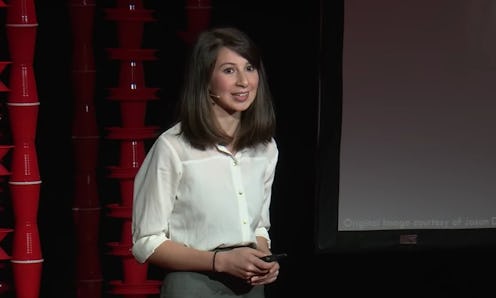Life
What To Know About Katie Bouman, The 29-Year-Old Scientist Responsible For The Black Hole Image
Unless you’re living under a rock or fell into a black hole, you likely saw the first ever picture of a supermassive black hole released yesterday by the European Commission. That image was made possible by Katie Bouman, who developed the black hole imaging algorithm which led to yesterday’s orange ring seen around the world. Just as that picture will likely grace the inside of science books to come, Bouman herself is history in the making.
Bouman is a 29-year-old computer scientist. She started developing the algorithm while studying as a PhD student at the Massachusetts Institute of Technology (MIT). There, Bouman led the project to develop an image of a black hole with assistance from MIT's Computer Science and Artificial Intelligence Laboratory, the Harvard-Smithsonian Center for Astrophysics and the MIT Haystack Observatory. As Bouman would later state in her 2016 TED Talk, in order to take a picture of a black hole, “we would need a telescope the size of the entire Earth.”
While science has yet to create one Earth-sized telescope, Bouman figured out a way to combine data from multiple telescopes around the world. (Eight radio telescopes, to be exact.) Over the past three years, the Event Horizon Telescope project collected “millions of gigabytes of data” about M87, the galaxy where the supermassive black hole was located. However, there were still gaps in the data Bouman and her team would need to fill in.
Enter, CHIRP or “Continuous High-resolution Image Reconstruction using Patch priors.” CHIRP is Bouman’s algorithm and the reason you now know what a black hole looks like.
In 2016, MIT announced the development of CHIRP. As Bouman explained in the press release, “A black hole is very, very far away and very compact.” She compared capturing a picture of a black hole at the center of the Milky Way galaxy to “taking an image of a grapefruit on the moon, but with a radio telescope.”
CHIRP pieces together the information gathered by the network of telescopes that make up the Event Horizon Telescope. “Just as a forensic sketch artist uses limited descriptions to piece together a picture using their knowledge of face structure,” Bouman explains in her TED Talk, “the imaging algorithms I develop use our limited telescope data to guide us to a picture that also looks like stuff in our universe.”
“3 years ago MIT grad student Katie Bouman led the creation of a new algorithm to produce the first-ever image of a black hole,” MIT’s Computer Science & Artificial Intelligence Lab tweeted yesterday. “Today, that image was released.”
“When we saw it for the first time, we were all in disbelief. It was quite spectacular,” Bouman told BBC Radio 5. “We got really lucky with the weather ... We got lucky in so many ways.”
Bouman also shared a photo to her reaction to the image in a Facebook post: ”Watching in disbelief as the first image I ever made of a black hole was in the process of being reconstructed.” As MIT CSAIL responded in a tweet, “Just to clarify, this was the first image *ANYONE EVER MADE* of a black hole.”
“No one of us could've done it alone,” Bouman told CNN. “It came together because of lots of different people from many backgrounds.”
During her 2016 TED Talk, Bouman also emphasized the importance diverse backgrounds played in this project:
“It still amazes me that although I began this project with no background in astrophysics, what we have achieved through this unique collaboration could result in the very first images of a black hole. But big projects like the Event Horizon Telescope are successful due to all the interdisciplinary expertise different people bring to the table. We're a melting pot of astronomers, physicists, mathematicians and engineers. This is what will make it soon possible to achieve something once thought impossible.”
Bouman is currently a postdoctoral fellow with Event Horizon Telescope and, per CNN, will start working as an assistant professor in Caltech’s computing and mathematical sciences department in the Fall.
